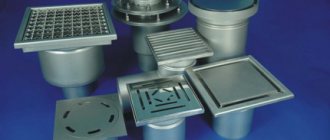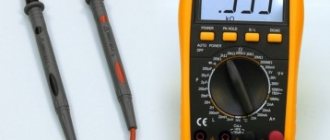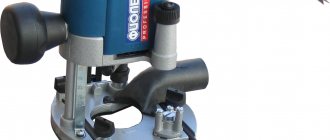Pendulum mechanism of a jigsaw, principle of operation
It is worth paying attention to the domestically produced Interskol jigsaw. It is produced in Izhevsk. For domestic use this is a completely acceptable option. It has many positive qualities, and the most impressive is its low cost. But there are also disadvantages.
This is the curvature of the saw. What is the problem, and is it possible to get rid of it? The culprit was the quick-release fastening of the file. The fact is that it is designed for saw blades of maximum thickness. All cutting tools of smaller thickness simply dangle in the mount.
How to get out of this situation? You need to replace the quick-release mount with a simple device with regular bolts. It's not difficult to make. You need to take a square rod, cut two blanks, drill holes in them and connect them with two M5 bolts and nuts. The procedure for attaching the saw blade will become somewhat more complicated, but the tool will produce an even cut.
Read also: Mutual Fund. Mutual investment funds of Russia
In addition, you can modify the design of the tool itself and limit the movement of the file in the transverse plane.
To do this you need:
- take sheet aluminum and cut the plate to the size of the jigsaw sole;
- In the front part of the workpiece, it is necessary to make a cut to the size of the working area of the cutting tool. File all edges, make bevels on the inner longitudinal edges of the cutout;
- You need to cut a plate from plexiglass to the size of the working area of the saw blade. File all sharp edges and make reverse bevels on the outer longitudinal edges;
- The aluminum plate must be marked for its installation on the jigsaw base. Drill holes and make chamfers for installing countersunk screws;
- A piece of plexiglass must be inserted into an aluminum plate, having first made a cut at its location.
Now, during operation, the saw blade will be limited in transverse movement almost in the cutting zone, which will give it even greater straightness.
Electrical problems
Problems with the motor and electrical components of a jigsaw can cause a variety of consequences. There is a list of typical faults.
The brushes sparkle
The graphite brushes that transmit voltage to the motor rotor are subject to wear. This is a planned phenomenon. Therefore, if sparks appear in the tool body or incomplete power delivery, it is enough to replace a pair of brushes. Most jigsaws are equipped with units for quick installation.
Graphite brushes wear out over time and need to be replaced
Replacing the saw holder
Replacing some types of fasteners is much easier than finding these parts. To perform a similar operation with block and screw clamps, you do not even need to unscrew the tool body. Saw holders of this type are attached to the end of the rod using one or two screws, which makes it quite convenient to change them.
In the case of some screw fasteners, replacement will require removing the rod to more conveniently and securely fix the holder. The video below about repairing a jigsaw with your own hands clearly demonstrates the process of replacing the shoe-type fastening. If things are relatively simple with simple saw holders, then replacing a quick-clamping one can cause some difficulties, especially for an inexperienced craftsman.
How to cut chipboard, laminate
Next, we’ll look at how to evenly saw off chipboard with a jigsaw to avoid damage to the laminated front surface.
Read also: Where and why gabbro-diabase is used
Choosing a file. Experts recommend using a reverse cut file. True, during the work there may be a feeling of discomfort due to increased vibration, but the quality of the cut will not suffer. If sawing is performed with a regular file, work is carried out on the back side of the material being processed.
Stroke frequency. The stroke frequency must be set to maximum.
Pendulum mechanism. To prevent chips from forming, the pendulum mechanism must be turned off.
Sawing process. The tool must be pressed firmly against the surface of the material, and it must be moved smoothly without strong pressure.
Chips appear precisely on that part of the material that faces the tool. Therefore, if the cut is made with a file with regular teeth, then you can, having determined the front side of the product in advance, make a cut along the back side.
In addition, an anti-splinter insert can be used to make cuts in chipboard or laminate. This is a small part with a cut that is inserted into special guides on the sole. The most ideal insert is the one in which the cut exactly matches the thickness of the saw blade. Therefore, some manufacturers supply several of these inserts complete with jigsaws. In this case, you need to make the cut in each of them yourself. After which you can start sawing the chipboard.
Repair steps
It is easy to disassemble the tool. The case is divided into two halves, allowing access to all parts of the mechanics. The first step is to remove contaminants and replace the lubricant, after which you can begin repairs.
Replacing stem bushings
Let us note right away that there are no spare parts in stores. You can find the appropriate part by purchasing a broken tool at a flea market. Parts from other devices and mechanisms are often suitable. For example, jigsaws with a round stem exit are the easiest to repair. A round bushing is selected; if necessary, the internal diameter is increased by stuffing it onto a cone. This repair allows you to eliminate runout and play of the rod, and improve the quality of the cut.
If necessary, unique fixing clips are also made (depending on the jigsaw model). When installing them in the housing, copper foil can be used as small pads.
Replacing the rod
In inexpensive jigsaw models, the rod is a thin metal plate of complex shape. If overloaded, it may simply burst. The part is replaceable, some jigsaw models are compatible with others. The device must be carefully disassembled, recording the process in the photo, in order to reassemble it. Then, with the part removed, go to the market or store. Then install the part and apply lubricant.
Jigsaw rod
Replacing brushes
Most models of jigsaws, unless we are talking about frankly budget ones, come with a pair of pullers. To replace them, just open the housing: in the rear of the engine, on the contact block, the necessary elements are immediately visible. Repair is simple: old parts are carefully removed, contact pads are cleaned of dust, and wiped with alcohol. After this, it is enough to install new brushes.
Replacing the start button with speed control
You can purchase a replacement part both at specialized points and in stores that sell spare parts for electronic devices. The jigsaw body opens and the corresponding part is freed from the wire leads. This often needs to be done after unscrewing the terminal screws. Modern models do not force you to use a soldering iron. After removing the old one, the new part is installed and connected.
It is better to disassemble the case and remove the button before going to the store to buy exactly the same part for the seat.
Jigsaw start button
A fairly rare failure is the failure of the engine thermal fuse. The part is being replaced. Sparking may be observed, which indicates not only a heavy load, but also wear on the brushes and lack of lubrication. Therefore, periodic maintenance is the key to reliable operation of the jigsaw.
How to use the pendulum mode of a jigsaw
For the pendulum mode in an electric jigsaw to be truly useful, you need to understand how to use it correctly. Most instrument models are equipped with adjustment of the amplitude of oscillatory movements. The operator can configure the pumping to suit the characteristics of the upcoming work and specific material.
Adjusting the pendulum stroke of the jigsaw
When choosing a pumping stage in a jigsaw, you need to take into account the density of the material and the cutting mode. The tool has four speeds in total:
- First. The pendulum stroke is inactive or is running at the lowest power. These settings are used for sawing metal and thin wood pieces, as well as for curved cutting.
- Second. The canvas makes small oscillatory movements. You need to process ordinary wood and fairly soft non-ferrous metals at this speed.
- Third. The file moves along a pendulum amplitude at an average speed. The mode is suitable for cutting thin plywood pieces and plastic.
- Fourth. At maximum speed, it is recommended to cut wood with a thickness of 5 cm.
If the pendulum control is at zero, this means that the function is completely disabled. In this case, the jigsaw file will only move up and down.
You can cut aluminum and copper with the pendulum action turned on, but it is better to cut steel in normal mode
Disadvantages of use
Despite the large number of advantages, there are also disadvantages. Disadvantages of models with paging:
Figure 3 – Pendulum stroke of a jigsaw
- the appearance of chips at the edges of the lines, unevenness of the cut;
- impossibility of use for figured cutting;
- The pendulum stroke does not work with ceramic tiles and hard metals.
Manufacturers recommend choosing a model taking into account specific tasks.
All devices with paging have the ability to disable this function, which increases the variability of the use of the tool.
Important ! When choosing a model, you should pay attention to the smooth switching of the pumping mode. This allows you to avoid various damage to the cutting line during operation.
How to control the pendulum stroke?
And so, we have already figured out that your electric jigsaw has such a function, so now you just need to understand what exactly it does and how you can use it.
In fact, everything is extremely simple. If you do not turn on the pendulum function, the jigsaw blade will only move up and down in translational movements. This is what allows us to cut wood, but unfortunately, not as quickly as we would like.
Now let’s imagine that you turned on, well, let’s say the first pendulum stroke on an electric jigsaw. The file will not only move up and down, but also bend to the side, against its cutting edge and back. Thus, the cut will no longer be at a straight angle, but at a sharper angle, which will slightly speed up the cutting process itself.
The higher the number on the pendulum adjuster, the sharper the angle of inclination of the cutting edge will be. Accordingly, the speed will increase significantly, since in one translational movement, the saw will be able to cut at least twice as much as in the standard mode without pendulum movement.
Accuracy problems
Let's look at how to cut smoothly with a jigsaw:
- The object to be processed must be securely fastened. Moreover, in such a way that it would be convenient to make the cut.
- In cases of particular uncertainty or for greater guarantee of accuracy, it makes sense to use guides. When making a straight cut, you can use a wooden block fixed along the marking as a guide. If the cut shape is complex, then the situation becomes more complicated. In this case, you can use patterns, if any, or you will have to reduce the speed of work by more carefully guiding the jigsaw.
- One of the options why a jigsaw cuts crookedly is problems with the saw. It may be dull or have chipped teeth. If you notice that the jigsaw literally turns itself wherever it likes, inspect the saw.
- Jigsaw failure. For example, if the motor runs jerkily, the likelihood of a crooked cut increases sharply. Likewise, other mechanism failures can lead to a decrease in accuracy. Such problems are difficult to eliminate on site, as they require diagnostics and, possibly, repairs.
- Finally, the accuracy of the work is greatly influenced by the skill of the performer. If you are a novice carpenter, do not be discouraged by periodic failures: accuracy comes with experience.
Parts that make up a jigsaw
- Engine housing. The most demanding part of the tool in terms of strength, since it is in it that the engine is located, the rotational movement of which, through the shaft and gearbox, is converted into the reciprocating movement of the slider. In turn, the main cutting part of the jigsaw – the saw blade or file – is attached to the slide.
- Gearbox. Sometimes it is made of plastic, which not only reduces the strength of the tool, but also impairs its heat transfer. As a result, such a tool will heat up faster and is more likely to fail quickly. Therefore, a metal gearbox housing is more preferable.
- Sole. This element of the device plays an important role in performing accurate, high-quality cuts of the material. Inexpensive models often use a stamped plate made of metal or, even worse, plastic. You shouldn't expect high-quality work with such a tool. The most preferred option is a cast metal sole. In addition to the material from which it is made, the reliability of its attachment to the jigsaw also plays a role. The fastening must be reliable and without backlash.
- Lever.
Types of jigsaw handles
- In the form of a staple. An example of such jigsaws would be Makita model 4327, Makita 4329. They are convenient to use for cutting work, where a lot of curved cuts are not required.
- D-shaped. Representatives of this class are the Hitachi models CJ 110 MV and CJ 120 V. With such a handle, large, smooth cutting lines are easily achieved.
- Mushroom-shaped. BOSCH uses such handles in the GST 120E and GST135CE jigsaws. The mushroom-shaped handle allows you to perform shaped cuts with the highest quality, where turning requires a constant change in the grip of the tool by the operator’s hand.
Hacksaw blade or file. As for the choice of saw blades for a jigsaw, this is also an important point to ensure the quality of the cut is at the proper level. The basic principle in selecting a saw blade is this: for different types of work and different materials you need to use only the appropriate blades. This extends the life of both the file and the tool itself.
Saw blades vary according to:
- The material from which they are made.
- Teeth pitch.
- Method of sharpening and setting.
- The shape of the blade and teeth.
Classification of paintings:
- Made of high carbon steel (HCS marking) – they themselves are quite flexible and are designed to work with soft materials.
- Made from High Speed Tool Steel (HSS) – for tougher materials.
- Made of bimetal (BiM) - a combination of the flexibility of the blade itself and the hardness of its teeth (or spraying). Accordingly, the blade is HCS, the teeth are HSS.
- Made of durable material, HM/TC allows you to work with fiberglass and even tiles.
- With wavy edge. Used for working with non-ferrous metals.
- For ceramics, glass and other hard materials, diamond or other coated files are used; with hard alloy tips.
- Special cloths for tiles.
Anti-splinter device.
To avoid chipping the material being cut and to obtain a clean cut, use various anti-splinter devices. For example, Makita 4351FCT; "Bosch" models GST 85PE, GST 120E (BE), GST 135BCE (CE). Reducing chipping is facilitated by choosing the appropriate blade and the optimal speed of its movement.
Other important technical characteristics and control features of jigsaws include (varies depending on the manufacturer and model):
- adjustment of saw speed;
- limiting the inrush current at start;
- multi-stage pendulum stroke;
- the ability to quickly replace the file without additional tools;
- tool-free tilt adjustment of the base plate for bevel cuts;
- sawdust removal system and connection to a vacuum cleaner;
- illumination of the working area.
When buying a tool, pay attention to these features of jigsaws, choosing the best option for yourself
Which is better to choose?
The market offers a wide range of models of electric jigsaws from foreign and domestic manufacturers. They differ in functionality, price and additional options. There are also jigsaws without a pendulum stroke. Below you will find the 5 best models for any production task.
RedVerg Basic JS600
Budget tool for straight and curved cuts. The device is strong, there is no play on the moving elements. There is a rubberized handle, the motor is equipped with double winding. Supplied with cutting blade, fence and adjustment key. Power – 600 W, stroke frequency up to 3 thousand movements per minute. Can be used for wood up to 5 cm thick.
Stanley STSJ0600-B9
Reliable and functional jigsaw for the professional segment. Works with wood, metal and other common materials. There is a convenient compartment for storing the saw, a protective screen and a handle with a rubber layer. Power – 600 W, maximum thickness of wood blanks – 8.5 cm.
Kolner KJS 800VCL
Professional jigsaw with a power of 500 W. Supplied in a rich set. There is a protective screen, a set of files and a plastic case for storage and transportation. Additional elements - parallel stop, adapter for vacuum cleaner. It is possible to adjust the operating mode, there is a laser guide.
Hammer LZK650L
An inexpensive model in the budget segment, equipped with a reliable 600 W motor. The jigsaw has a strong cast steel sole, smooth start and a protective screen. Tolerates long-term loads with mode switching well. Advantages: the ability to connect a vacuum cleaner, an anti-vibration system and adjustable pumping speed.
Bison L-710-80
Compact jigsaw of domestic production. Suitable for working with thin materials, can produce precise cuts on surfaces. The engine power is 750 W, the maximum permissible thickness of a wooden piece is 5 cm. There is a pumping mode, the ability to connect a vacuum cleaner and tilt the sole. Supplied with tuning key and wood saw.
Important ! Modern models of jigsaws with a pendulum mechanism have a fixed maximum saw speed of 3000 movements per minute. It depends on the selected mode and workpiece material.
A jigsaw with pumping (orbital) is a functional tool for sawing wood, metal, plastic and combined materials. Thanks to the pendulum stroke, sawing speed increases, making it possible to work with large and soft products. The advantages of such a device are control of the cutting blade movement mode, high speed and prompt removal of chips.
Functional content
If everything is more or less simple with the basic elements of a jigsaw and their set is usually standard, then additional options for professional processing of material need to be dealt with more thoroughly. So, modern hand-held equipment can demonstrate the following capabilities:
- stroke frequency adjustment. The selection of the required parameter can be done both before starting work and during the process, increasing the pressure on the start button, thereby increasing productivity. Do not forget that with such manipulations the file wears out much faster;
- connection of a multi-stage pendulum mechanism. Most modern jigsaws include a function that allows you to increase the number of horizontal movements of the cutter in the cutting direction and in the opposite direction. In this case, the file will not wear out faster, but the cutting edge will be less neat. When performing a high-quality finishing cut, it is better to disable this option, especially when it comes to processing sheet steel and hard wood;
- illumination of the working area. The lamp integrated into the tool body optimizes the cutting process and makes it more comfortable in places with insufficient lighting;
- Changing the cutting blade without a key. Quick blade replacement using a special lever allows you to save time on re-equipping the unit and quickly install the selected cutter;
- automatic removal of sawdust. A fan designed to cool the electric drive expands its functionality and allows you to promptly remove sawdust from the cutting line, which is especially important when performing woodwork;
- Availability of an adapter for connecting a vacuum cleaner. This feature ensures thorough cleaning of the surface being processed from chips and dust, thereby improving visibility of the cutting line;
- turning the saw. A very convenient function, thanks to which the cutting element of the jigsaw rotates 360 degrees, which is indispensable when forming holes of a round configuration;
- fixing the inclination of the sole. Using the clamp, you can secure the home jigsaw in the selected position at a given angle (from 0 to 45 degrees).
Pendulum stroke
The pendulum function of an electric jigsaw significantly expands the capabilities of the tool. Experienced craftsmen know why a pendulum stroke is needed and in what cases the device is indispensable, and we will be happy to tell beginners about this useful option. Thus, the saw blade of a jigsaw with a pendulum stroke during operation, in addition to the reciprocating action, additionally performs a horizontal movement in the direction of sawing and in the opposite direction. This mechanism is designed in such a way that it allows you to quickly cut a part while the tool moves upward. Many models of units provide adjustment of the amplitude of the pendulum stroke, which allows you to select the desired cutting mode depending on the characteristics of the workpiece. The more steps the regulator has, the more accurately the master will be able to adjust the device, choosing the optimal balance between the cleanliness of the cut and the speed of work.
As you can see, choosing a jigsaw requires a balanced approach and careful study of the issue, and here you need to take into account not only the technical characteristics of the unit that you are going to purchase, but it is also advisable to familiarize yourself with some other subtleties. By analogy with other working tools, manufacturers produce jigsaws for household or professional use, and which of the samples is the best, we’ll try to figure it out in the next section of our article.
Kinds
Jigsaws have a wide range of characteristics and parameters, so they are divided into groups for home and professional use. In turn, each of these types has its own characteristics. Popular are manual options, for figured cutting, with adjustable speeds, and tape.
A worthy option for a quality tool is a mini jigsaw. It is able to simplify precise sawing and sanding of the model due to the high rigidity of the working parts. This product can be used not only by professionals, but also by beginners. The jigsaw is easy to use and is an excellent option for sawing a variety of materials. Purchasing a tool will make it easier to make a tabletop or drawer.
Professional
Jigsaws with professional purposes meet high requirements, which are determined by high functionality, productivity, reliability, and ergonomics. Such a tool can withstand heavy loads and function continuously for 7 hours. Functionality of professional jigsaws:
- cutting wood material that has a thickness of 8 to 13.5 cm;
- steel billet with a thickness of up to 1 cm;
- aluminum plates – up to 2 cm.
The performance of such a tool is directly affected by the power reserve. The more powerful the engine the device has, the easier and faster the work is done. The reliability of professional jigsaws ensures their long service life and infrequent failures.
Domestic
An electric jigsaw for home use is considered inexpensive. It is quite easy to use, so it can be used to perform various functions at home and in the country. Experts note the good power of the device, so it is capable of performing all assigned tasks. Features of household jigsaws:
- low power;
- availability of a choice of additional functions;
- comfortable work with wood material that has a thickness of no more than 7 cm;
- high-quality cutting of steel with a thickness of up to 4 cm;
- the duration of operation should not be more than 20 hours per month;
- low cost of goods.
If you want to purchase an electric jigsaw, you first need to decide on the features of its use.
How to use: operating instructions and safety precautions
If the cutting speed needs to be increased, there is no need to put pressure on the jigsaw handle and “adjust” it. It is better to adjust the rotation mode of the motor and pendulum
The correct selection of the file is also important. The workpiece must be securely mounted on the workbench. You should never saw while holding the workpiece suspended in your hands.
Good fasteners will give good results - cutting accuracy, speed and quality of sawed edges. Straight cuts are made using a ruler that is included with the jigsaw (linear clamp). Round holes and curved lines on thin plywood or plastic are cut better when the jigsaw is secured with the blade up and the part is fed to the cutting tool. Smooth circles can be made using a circle cutter. Making a cut on a thin metal surface is much more convenient if you put plywood under the sheet. This will prevent the edges of the metal from deforming. If there is a noticeable decrease in sawing speed, it is recommended to immediately replace the saw blade. Prolonged use of a dull blade will cause engine overheating with all the ensuing consequences. If the cut needs to be made at an angle, the support sole is shifted by the required number of degrees. When working in cold weather, it is advisable to run the engine at idle speed for 1–2 minutes. After this, you can work in load mode. Take breaks from work whenever possible. Stop for 5-10 minutes every half hour.
We also list the basic safety rules.
- When working, it is recommended to wear work clothing that does not have fluttering hems or dangling sleeves. Hair must be tucked under a headdress. Body position is stable.
- Do not slow down the movement of the saw with your hands or a clamp.
- It is unacceptable to leave a switched on and working tool unattended.
- Use the tool only for its intended purpose. Do not hammer nails with a saw.
- If you discover damage to the housing or other functional breakdowns, you need to stop working and fix the problem.
- The power cord can only be turned on and off when the engine is off.
- Do not allow minor children to play with the instrument. Is it dangerous.
How to properly cut various materials with a jigsaw
With practice and experience comes knowledge. But at first, a novice user will need information on how and with what to cut different parts.
- Wood, plywood and laminate are the main materials that a jigsaw is designed to cut. If the cut is rough, you can use high speeds and oscillations of the pendulum. This will increase speed, but reduce quality and accuracy. Precise sections, depending on the density of the material, are sawed at medium speeds, with the pendulum turned off. This is especially true for laminate if it is precisely adjusted. On a six-point scale - 5.6.
- Metal parts, including pipes, are cut at low speeds without turning on the pendulum (or use the pendulum at low speed). 1.2 speed. Corrugated sheets and sheet iron are sawed at speed 1, making sure that the edges do not curl. For aluminum and other non-ferrous metals, the speed can rise to 3–4 levels.
- Plastic and plexiglass can be cut at high speeds, but care must be taken to ensure that the material does not melt. 4–6 on a six-point scale.
- Ceramic tiles, as well as other hard types of stone cladding, are processed at speed 4–5. The pendulum is installed in the initial positions.
- Drywall can be cut at high speed and with maximum swing of the pendulum. A natural limitation is the level of dust. If cutting occurs indoors, the dust from cutting can be very high. And so the speed is reduced.
Laminate is cut at high speed with the pendulum mechanism turned off
Tips for use
The pendulum mechanism is more difficult to operate, regardless of the density of the material. Recommendations for working with this tool:
- Do not put pressure on the jigsaw while sawing.
- The device must be firmly fixed to the surface.
- For precise cutting, the workpiece must be held level and moved at a constant speed.
- Place a sheet of plywood or chipboard under the device to reduce vibration when working with thin workpieces.
- Use machine oil when sawing metal and plexiglass.
Before starting operation, carefully read the manufacturer’s instructions, and also test the orbital jigsaw. To avoid getting shavings or sawdust in your eyes, you should wear goggles and work only with protective gloves.
Useful jigsaw options
Modern jigsaws have a lot of useful options. Such design additions not only expand the capabilities of the tool, but also make working with it as convenient as possible. What are these options?
Electronic speed control system
Allows you to select the optimal saw blade speed for a specific task.
The highest speed of the blade (2800-3500 strokes/min) is not always required. When sawing metal or plastic, or cutting out small curves in solid wood with a jigsaw, you will have to slow down the speed. Otherwise, the blade and workpiece will overheat.
A speed control system is present in most jigsaws, although there are models without this option. For adjustment, as a rule, a wheel is provided, although in some cases the frequency is selected by pressing the switch button.
Speaking of electronics, I will also mention the speed stabilization system, which, when the tool is loaded, maintains the stroke frequency at a constant level.
Backlight
Provides good visibility and protects eyesight.
LEDs built next to the rod provide excellent illumination of the work area and guarantee good visibility of the marking line even in twilight conditions
This is important, because cutting with a jigsaw often requires precision. If there is no backlight, then when working in the shade or with dim light you will have to strain your eyes, and the drawn line can easily be lost sight of
Pendulum stroke
Significantly increases the productivity of the jigsaw.
A separate lever on the body makes the blade move not only up and down, but also move back and forth with a small amplitude. This pumping forces the saw teeth to bite into the wood more aggressively, which significantly speeds up the sawing process, although it contributes to the formation of many large chips.
In order to feel the increase in productivity, it is enough to saw through a thick construction board (50 mm thick), first with the pumping turned off, and then with the maximum. In the first case, the tool will cut extremely reluctantly, requiring significant effort from your hand; in the second, it will quickly cope with the workpiece even without strong pressure. The pendulum stroke of jigsaws is adjustable, and the general pattern is this: the higher the level, the stronger the pumping.
In other words: • zero stage means that the pendulum stroke is disabled; • the first stage sets a slight pumping;
• the highest stage provides maximum pumping. True, in practice it is not always possible to notice the difference between the last two steps.
Quick release blade lock
Makes it easier to replace the blade.
The main advantage of a quick-release lock is that it does not require a hex key or screwdriver. You are required to move aside or press the spring-loaded bracket and insert the file into the lock. The quick-release lock is not always executed perfectly, but you will not face situations where the work “stands up” due to a lost hexagon.
Sawdust blow/suction switch
Improves the visibility of markings and promotes efficient removal of sawdust.
As a rule, such a switch is made in the form of a small two-position lever. The “blow” position directs a powerful air stream into the cutting area, which completely sweeps away sawdust and ensures good visibility of the markings. The second position is used in cases where a construction vacuum cleaner is attached to the jigsaw: it blocks blowing, which would interfere with the effective operation of the vacuum cleaner.
Quick fixation of the sole
Makes it easier to adjust the sole.
Sawing with a jigsaw often requires preliminary adjustment of the sole of the tool. This can be an adjustment at an angle of 45 degrees or fine adjustment using a square for a strictly perpendicular cut. In any case, the fixation of the sole will have to be loosened. This is usually done using a hexagon, but a number of advanced models have a special lever: loosen it, set the angle of the sole and tighten the lever back.
Additional guide mechanism for saw blade
Prevents the blade from being pulled away, which means it increases sawing accuracy.
This mechanism is rare (usually found in expensive professional jigsaws). It is made in the form of two carbide “jaws”, which press the blade from the side and, thereby, prevent bending of the sawing equipment. The benefit of such a modification is undeniable, because the most serious problem when working with a jigsaw is the removal of the elastic fabric in the array.
Images used in this article: ,
Device structure
An electric jigsaw is designed for cutting various sheet materials. Depending on the purpose, jigsaws are:
- professional;
- semi-professional:
- household
The differences lie in the technical characteristics and functionality of the tools.
Jigsaw device
Before you learn how to use a jigsaw, you need to familiarize yourself with its structure. The tool consists of:
- Aluminum housing.
- Electric motor. A powerful device will be able to cut thicker and stronger material.
- Gearbox covers.
- Pendulum control buttons. The pendulum mechanism allows you to make an accurate cut of materials with low density (soft wood, plywood, foam).
- Covers and brackets that ensure safe operation.
- Support roller for guiding the saw.
- Chip blower regulator.
- Regulator of the number of saw strokes, on which the speed of its movement depends.
- Plate tilt regulator. It allows you to cut wood at an angle of 15, 30, 45 and 90 degrees.
- Laser guide. Allows you to adhere to the drawn cutting line.
- A quick-release chuck that performs the functions of a saw.
- A battery, thanks to which you can cut with a jigsaw for some time without connecting to the network.











